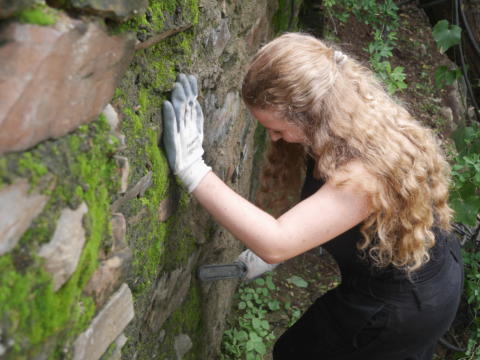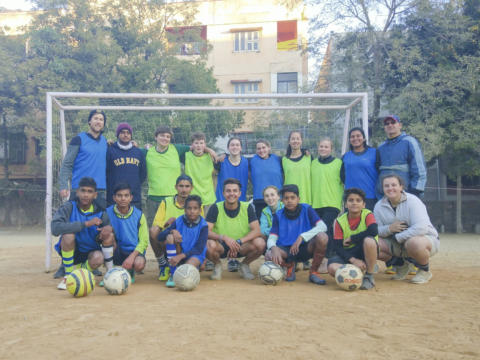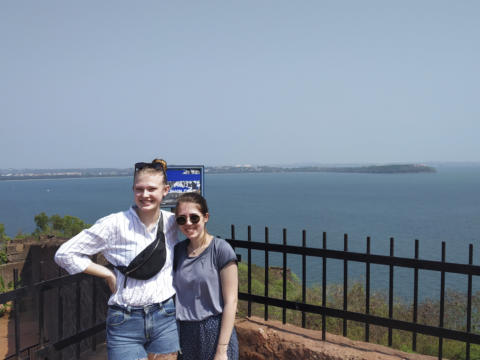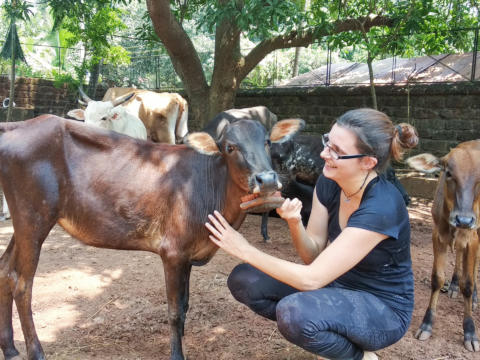Only 360€ per week!
Community Engagement Program
Goa - India
Community Engagement Program
Goa - India
By lending your time and effort you will help in improving the quality of life of the local communities in Goa.
Participate in our endeavour to empower the local women through education and life skills, assist in help at a disability care home, and provide social support to elderly people at home for the aged. Join us in this program to inspire the less privileged and help the community to build on their own.
Program Description
ELDERLY CARE
Who the Project serves:
With modernization, people are at a race for achievements which puts the concept of the nuclear family in focus. When the grown children in the family are pursuing their dream jobs and leave their family behind, there is no one to look after their parents. Therefore, they are placed in an Elders care home.
In this program, you would visit an old age home and spend time with its residents as they need someone to listen or talk to and it is all that they need sometimes. Your visits would make them feel happier and less lonely. You will spend time as a companion to the residents where you can talk to them, play games, do reading, colouring and various other exercises with them.
Working Hours: Monday to Friday 09.30 to 1200
Your role:
To engage the residents at the Old Age Home in different activities
- Play games and entertain them
- Talk to them and listen to what they have to say
- Read to them
- Organize recreational and entertainment evenings for the elderly
- Arrange sharing and discussion sessions on interesting topics
- Teach the residents skills such as how to use their mobile phones better to store numbers, send text messages, take pictures, etc
- Take the residents to museums and other places of interest
- Celebrate festivals and birthdays with the elderly
SPECIAL NEEDS EDUCATION AND CARE
Who the Project serves:
It is a home for adults with different levels of abilities. This Home was born out of a need to create an inclusive place where adults with intellectual disabilities feel welcome. With your help, we hope to create a healthier society for these differently-abled individuals.
Working Hours: Monday to Friday 09.00 to 1200
Your role:
- Assist the members to learn and improve their skills as per their abilities and interests
- Share moments of happiness and love with the young and old in the free time
- Assist them physically with basic tasks like walking them to the garden, having lunch or helping out at the work table
- Give them a sense of value in their lives and the attention they seek
- Teach them simple singalong songs
- Assist the residents with physical exercises
WOMEN EMPOWERMENT PROGRAM
Who the Project serves:
We have recently started the “Women Empowerment Program”. The objective of this program is to make the women self-reliant and to make them able to support their families. This program aims to empower women in various ways such as financially (in the beginning), mentally as well as physically. The target group of the program are women from less privileged backgrounds residing in various villages Goa.
Most of them are illiterate and work as housemaids and other unskilled jobs. In the mornings, some of them work as maids, cooks or engage in other small jobs where they are able to earn a living. And in the afternoon, they join our program to learn new skills and improve their lives better for a brighter future. In this program, through a step-by-step process, our main task is to give them English education (communicative and written English), awareness on health and hygiene, vocational training so that they can be financially stable in the future with their own businesses.
This project has started with teaching basic communicative and written English so that the women can read signboards, news papers, magazines and also help their children in their homework.
The project is conducted on a one-to-one basis where each participant takes part to teach women at the project.
Working hours: Monday to Friday 14.30 to 17.00
Your role
- Help improve the quality of life of the women and their families
- Provide vocational training and training material for women
- Inspire them to start their own business
Throughout the year there are various courses being conducted in this program such as baking, honey harvesting, tailoring and computer skills.
Aims & Objectives
The objective of the project is to inspire, care and help those who are in need in ways you can.
Schedule
Monday
On your first day of the program, you will have an orientation in order to better understand your new environment and the program. Our coordinators will take you to an enchanting spice plantation, the local market, and a few supermarkets located close to our center. You can also utilize this time of the day to exchange your currency or purchase any of the essential items you might need during your stay.
Tuesday
On the second day of your first week, an introduction to the local projects and programs will be given through an observation time at the project site. During this project introduction, you can also choose to assist the existing participants on the project. Our coordinator will also theoretically describe and train you on the activities of the project onsite so that it is easy for you to understand the project in a step-by-step manner. Your time on the project will commence on Wednesday.
Wednesday to Friday
Morning
In the morning, you can choose to join either the Elderly Care program or Special Needs Education and Care program.
09:00 – Departure to Elderly Care program /Special Needs Education and Care program
13:00 – Lunch
Afternoon
In the afternoon, you can choose to join the Women Empowerment program or continue at the Special Needs Education and Care program.
14:00 – Departure to Women Empowerment program
14:30 – Engage in tasks and activities at the project
17:00 – Return to your accommodation
Note: This schedule can be changed and/or amended depending on weather conditions, local conditions and unforeseen circumstances.
Note: Please also note, you will be placed on each of these projects based availability of the program after your arrival into the country. We will try to our best to keep you placed on a project that suits your preference.
Participant Criteria & Requirements
Standard Requirements
Minimum age: –
Maximum age: –
Minimum English level: Basic
CRB required: On Signup
Passport copy required: On Signup
Resume copy required: No
Required qualification: None
Additional Requirements
- Participants below the age of 18 should have parental consent.
- Participants above the age of 65 should have medical clearance.
Additional Equipment
Dress Code
- Cover up as much as possible in the spirit of the local culture to avoid embarrassment.
- Your clothes must not be too short, too tight or too revealing. Kindly make sure your shoulders and legs are covered.
- Dress professionally since you will be working in a professional environment while teaching the children.
- It is completely fine to wear western clothes as long as they fit the local standards
- Be thoughtful of the graphics, symbols or text printed on your clothing and avoid wearing clothing styles that might be inappropriate
- Be thoughtful to poor communities by not displaying expensive items and clothes
- Wearing local clothes could help you build a good working relationship with the community
Location
Consistently ranked among India’s top tourist destinations, Goa is the ideal place for first-time travelers and adventurers alike to acclimatize to a different culture. From caves behind waterfalls to villages hidden in sandy coconut forests, there is always something more waiting to be rediscovered. The mountain ranges and spice plantations enhance the beauty of this glorious state. Apart from its natural beauty, this former capital of Portuguese India and home to various UNESCO World Heritage sites has a lot to offer in terms of architecture with churches, cathedrals and forts abounding. Put together, it is all of these aspects and more that make Goa the ultimate travel destination.
About the Accommodation
In our centre, there is a mini library, a dining room, a lounge area where you can hang out with fellow participants and a beautiful garden to relax.
Furthermore, there is a refrigerator which you are welcome to use to store food and beverages.
Food Arrangements
The meals are a mix of Western and Indian food, consisting mainly of vegetarian dishes including rice and vegetables. You can expect to have a chicken dish about twice per week. You can also use the kitchen facilities to cook for yourself or eat out at any of the local restaurants.
Facilities
ATMs: There are ATM's around our centres. The closest one to our residence is about a 15-minute walk from the house.
Shop: The closest local supermarket is a 15-minute walk from the centre.
Activities & Events
No scheduled activities outside the program.
Sights & Surroundings
Goa has a very long coastline with an almost unbroken sand cover. So, if you’ve come looking for sun, sand and sea without the crowds and the fuss you’ll be pleased to discover these beaches tucked away in quiet recesses where you can go to truly escape the world. Here is our list of secluded beaches to try during your Goa weekend getaways. You might have to take your own food and water as there are no eateries or accommodation near some of them. And though some of them may seem out of their way, you’ll be glad for the peace and quiet when you get there.
- Butterfly Beach
- Kakolem Beach
- Galjibag Beach
- Hollant Beach
- Betul Beach
- Arambol Beach
- Agonda Beach
- Cola Beach
- Velsao Beach
- Sinquerim Beach
- Siridao Beach
Goa has a pleasant climate all around the year. Monsoon season is from June to September which is the rainy season for Goa. Goa gets an average rainfall of 330 cm annually which is about 90% of its annual rainfall. This season also happens to be the favourite of the travellers coming to Goa with its various celebrations happening. And from October to March it gets a very pleasant climate with clear skies and nights being busy with the festivals and sky full of fireworks. Summer starts in April and the long sandy beaches and the sunshine are so welcoming.
Transportation
From this location we do not provide free transport to other locations.
Quick Facts
Name: Republic of India (Bhārat Gaṇarājya)
Population: 1.252 billion
Capital: New Delhi
Language: Hindi, English and 22 other officially recognized languages
Currency: Indian Rupee (INR)
Time zone: UTC +5:30
Country Information
India is known for its pyramid-like temples, its colorful streets and it’s crowded cities. This country represents one of the most vivid and the largest cultures in the world. From the golden triangle of Delhi, Jaipur and Agra to the coast where Ayurveda medicine was born, India offers a 360 degree journey through the most magical of lands. Known for being the second most populated country in the world, India will show you the faces of thousands of Hindu gods in its very vast collection of temples all throughout the country. The land of colors and smiles is ready to take you on your next adventure whether road tripping or helping out in local communities, this sub-continent will amaze your senses. India will shift the way you see the world.
India’s literacy rate is around 60% for women and 80% for men. The principal language is Hindi and English is also commonly used in all major cities. New Delhi, the capital of India, is what many would call the real deal when travelling through the country. It is one of the biggest and most populated cities in the whole world with up to 25 million citizens. New Delhi is known for its amazing cuisine and its new modality of “street food”, which means restaurants with every specialty you can imagine are available to you all throughout the city! Chennai is another of the biggest cities in India, known as the “Detroit of India” for its automobile industry. If you are looking for a quieter spot Kerala is the centre of lifestyle, art, architecture, language and literature in all of the country!
Climate
India is so vast that climatic conditions in the far north have little relation to those of the extreme south. While the heat is building up to breaking point on the plains, the people of Ladakh, in the Himalaya, will still be waiting for the snow to melt on the high passes.
India has a three-season year – the hot, the wet and the cool. Generally, the best time to visit is during winter (November to February) although there are regional variations.
Summer (hot): The heat starts to build up on the northern plains of India from around February, and by April or May it really heats up. In central India temperatures of 45 °C and above are commonplace. Later in May, the first signs of the monsoon are visible in some areas – high humidity, violent electrical storms, short rain-storms and dust storms that turn day into night. The hot season is the time to leave the plains and retreat to the hills, and this is when Himalayan hill stations are at their best (and busiest). By early June, the snow on the passes into Ladakh melts and the roads reopen.
Monsoon (wet): When the monsoon finally arrives, it does not just suddenly appear. After some advance warning, the rain comes in steadily, generally starting around 1 June in the extreme south and sweeping north to cover the whole country by early July. The monsoon doesn’t really cool things down: at first hot dry and dusty weather is simply replaced by hot, humid, muddy conditions. Even so, it’s a welcome relief, not least for farmers who face their busiest time of year as they prepare fields for planting. It doesn’t rain solidly all day during the monsoon, but certainly rains virtually every day and the water tends to come down in buckets for a while followed by the sun. The main monsoon comes from the southwest, but the southeast coast is affected by the short and surprisingly wet northeast monsoon, which brings rain from mid-October to the end of December.
Winter (cool): Finally, around October, the monsoon ends for most of the country, and this is when most tourists visit. Generally, it’s not too hot and not too cool (although in October it can still be surprisingly humid in some regions). Delhi and other northern cities become quite cold at night in December and January. It certainly becomes cold in the far north. In the far south, where it never gets truly cool, the temperatures become comfortably warm.
Culture
Hinduism is a big part of the story and construction of Indian culture. India is known for its distinctive arts such as architecture, literature and performing arts but in the modern era it has shifted towards the film industry. Bollywood is followed by the Middle East, South Asia and even Russia! Their movies are known for its musical intake and beautiful stories and characters, all, native Indian. One of the things that characterize India the most is its caste system; this model includes the old tradition of arranged marriages and very traditional family values throughout castes and the country. Don’t miss a cricket match when you visit! It is the nation’s favourite sport and a beloved pastime in the country.
Hinduism, Islam, Christianity, Sikhism, Buddhism, Jainism and Zoroastrianism are the major religious communities in the country. According to the 1990 census, Hindus constitute about 83% of the population followed by Muslims with 11% and Christians with 2%. Sikhs constitute about 1.6 %. Buddhists 0.6% Jains 0.3% and Zoroastrians (Parsees) 0.085%, of the 1 billion population. The rest constitute other minor religions. The population of all the 6 major religions has increased but Jainism has increased only marginally. India is a land of bewildering diversity. It is a jigsaw puzzle of people of every faith and religion, living together creating a unique and colorful mosaic. There is a festival for every reason and season. Many festivals celebrate the various harvests, signifying great historical figures and events while much express devotion to the deities of different religions. Every celebration revolves around rituals of prayer, seeking blessings, exchanging goodwill, and decorating houses, wearing new clothes, music, dance and feasts.
Transportation
The Indian railways are one of the largest undertakings in the world. The network covers a distance of over 60,000 Km. Road covers 5.5 million kilometers and over 10,000 km of inland navigable waterways. Using rail and bus services, one can reach almost any point on the Indian map though not always on time. All large cities are also connected with domestic air services.
Buses operate frequently to all smaller towns to/from major cities. There are also inter-state buses that take you from one city to the other (non stop). Before booking your bus tickets, always check the time it would take from one point to the other. For the local buses, you buy the ticket once you get on. For the lines that go between cities you will have to book and pay in advance.





